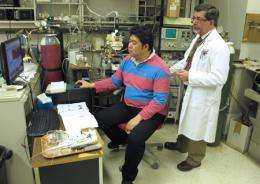Alzheimer's patients may get help from drug originated for diabetes

A researcher with the Faculty of Medicine & Dentistry at the University of Alberta has discovered that a drug originally intended for diabetes may hold promise in the fight against Alzheimer's disease.
During tests in his lab, Jack Jhamandas, of the faculty’s Division of Neurology and his team discovered that that drug AC253, developed for diabetes but never put on the market, blocked the toxic effects of a protein that is deposited in large quantities in the brains of Alzheimer’s patients. This beta amyloid protein, which is linked to the cause of Alzheimer’s, makes brain cells toxic—ultimately causing the brain cells to die.
“From the point-of-view of therapies, it may open up some new avenues for us to explore in terms of treatment for Alzheimer’s disease,” says Jhamandas. “I think patients with this condition, their families and caregivers, live on a word called ‘hope’ and this is a type of a discovery that engenders that hope, that ignites that hope and that keeps it burning.”
Jhamandas and his research team, who are funded by the Canadian Institutes of Health Research, published their results in the peer-reviewed American Journal of Pathology in January.
The team reported two other significant discoveries related to Alzheimer’s. They found a second way to block the toxic effects of beta amyloid protein, using a relatively new technique to “silence” a gene involved in the process of brain cell death. By silencing the gene, numerous processes triggering cell death were blocked, so they were able to prevent brain cells from dying.
“We altered the genes and low and behold, beta amyloid protein lost its ability to kill brain cells as effectively as it normally would,” says Jhamandas.
The third finding, this one in collaboration with David Westaway, a fellow Alzheimer’s researcher in the faculty, relates to basic understanding of the disease. They discovered the genes that could be silenced weren’t everywhere in the brain. Both these genes and the toxic protein were only found in large quantities in areas of the brain responsible for memory, learning and cognition, says Jhamandas.
“It was quite a surprising observation. We’re not sure what it fully means, so we are in the process of looking at this in brain tissue from Alzheimer’s patients.”
Jhamandas said some of the next steps for his research team are to inject a compound into the brains of lab models to see if learning and memory problems can be stopped or prevented. If that is the case, it “really could be the launching point for a development of compounds that could be tried in human clinical trials.
















